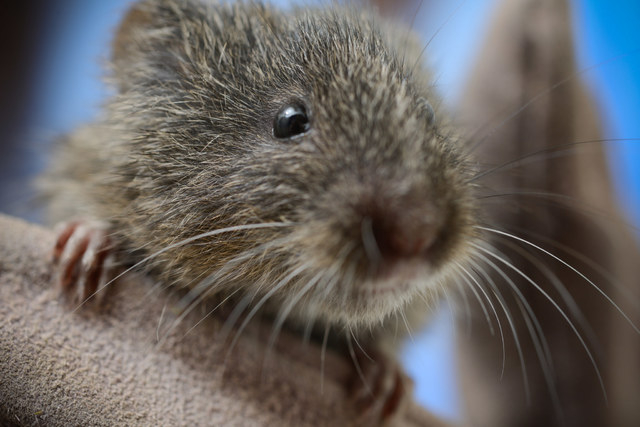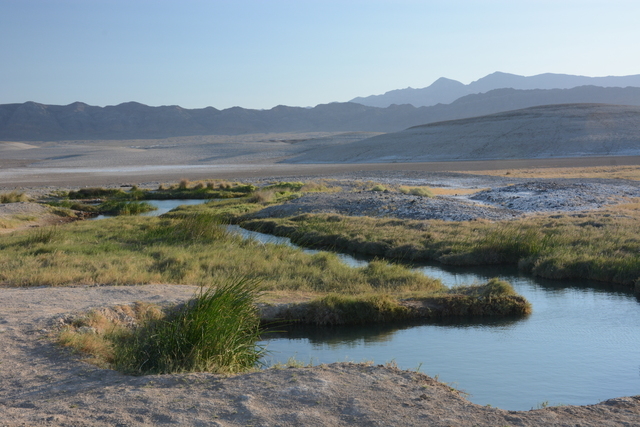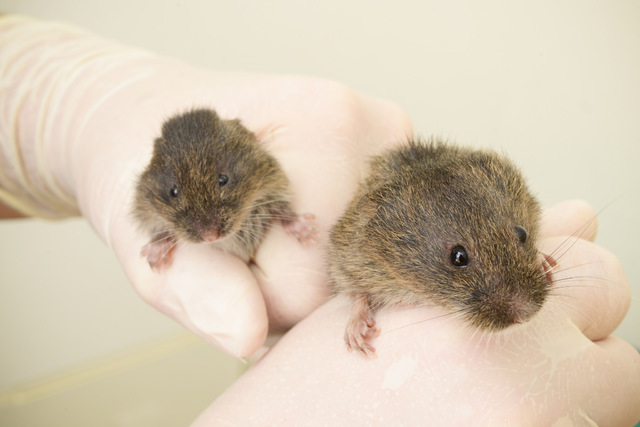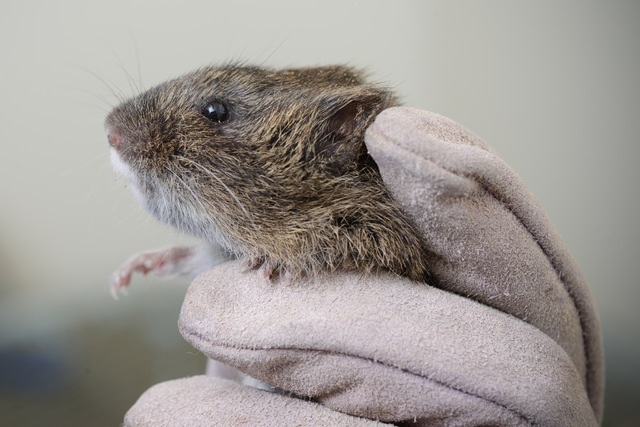Lost voles won’t stop effort to save endangered rodent
In the sun-baked desert 80 miles west of Las Vegas, you live where the landscape lets you.
For the Amargosa vole, home is beneath the bulrush in a handful of spring-fed marshes one mountain range removed from Death Valley.
But life has been particularly hard lately for one of North America’s most endangered mammals.
Over the past three years, drought and human disturbance have conspired to destroy most of the vole’s core habitat near the town of Tecopa, Calif., where roughly 90 percent of the tall green grass that once harbored the small rodent has turned brown as its water source disappeared.
Worried the species could die out completely in as little as a year, researchers quickly collected 20 juvenile voles last summer and carted them more than 500 miles to a lab at the University of California, Davis. There they established a breeding program so successful that by last month they were overrun with babies and ready to replace the 20 voles they had taken from the wild with 29 healthy youngsters born in captivity.
Then something unexpected happened April 13, as the lab-raised voles were transported to Tecopa to be released into the marshes.
“They died,” said U.C. Davis veterinary professor Janet Foley, co-leader of the species recovery project.
BACK FROM EXTINCTION
The Amargosa vole was first collected and described by naturalists in the late 1800s, but destruction of its native marshes by early settlers in Shoshone, Calif., led scientists to declare the animal extinct in the early 1900s.
The small, dark brown rodent was rediscovered in the late 1970s just down the road from Shoshone by a state fish and wildlife biologist conducting surveys near Tecopa.
California listed the vole as endangered in 1980, and the federal government followed suit four years later. That led to a few studies and planning documents over the next two decades, but little sustained work was done on the vole until the current effort got underway in 2010.
That’s a common misconception about the treatment of endangered species, according to Deana Clifford, a wildlife veterinarian with the California Department of Fish and Wildlife and Foley’s co-lead on the vole project. “People think listing means that its habitat is instantly protected, all the threats are under control and that gobs of money and people show up to do something about it,” Clifford said.
Today, the future of the Amargosa vole is in the hands of a team that includes members from the U.S. Fish and Wildlife Service, Bureau of Land Management, U.S. Geological Survey, the California Department of Fish and Wildlife, the Universities of California at Davis and Berkeley and the local nonprofit Amargosa Conservancy.
Susan Sorrells is one of the locals. She grew up in nearby Shoshone and now owns the tiny tourist town.
A big believer in both ecotourism and the power of nature, Sorrells already has carved out several acres of property as a refuge for wildlife including the Shoshone pupfish, which also was thought to be extinct until it was rediscovered in the area in the 1980s. Now Sorrells is working with the vole team to restore some habitat for the endangered rodent on a half acre right in the center of town.
It’s the least she can do. After all, her great-grandfather, R.J. “Dad” Fairbanks, founded Shoshone and probably played a role in wiping out the voles that used to live there.
Sorrells said Fairbanks was a freighter who ran a mule team into Death Valley in the late 1800s. To feed his team and protect his livelihood, he diverted spring water in the area to grow hay instead of bulrush.
“I don’t blame him for that,” she said. “It was a different time.”
Sorrells said she’s excited to be a part of the effort to return the vole to Shoshone.
“We are looking forward to creating habitat that would really bring the voles home to where they were first discovered,” she said.
LIKE RODENTS DO
It’s hard not to root for the little guys. With their round bodies and distinctive white beards, “they’re just charming,” Clifford said.
Foley described the vole as “bigger than your average chipmunk.” It weighs about the same as a deck of playing cards.
The Amargosa variety tends to be more docile than other types of voles, she said. “They will bite you, there’s no doubt about that,” but they also will sit calmly in your hand while you examine them or fit them with tracking collars.
“They’re so specialized and unique,” Clifford said, “yet most of world doesn’t know they exist.”
The vole team had hoped to spend a few years studying the rodent in the field and developing some detailed recovery actions. Instead, last year’s extinction scare forced them to rush into a captive breeding program with little research and only a rough draft of a plan in place.
So little was known about the animal, researchers weren’t even quite sure how to feed the ones they captured. When the animals refused to touch the bulrush in their cages, their handlers tried feeding them everything they could find in the produce section at the grocery store.
“The magic vegetable turned out to be jicama,” Foley said. “They lost some weight, but none of them died.”
Researchers eventually figured out that the voles would only eat bulrush if it was upright because they like to climb up into it and chew from the top down.
The breeding part of the program went much more smoothly.
“By October, they were breeding like gangbusters, and we had very good survival (rates),” Foley said. “We were making a lot of voles.”
So many, in fact, that by Christmas they had to separate their breeding pairs to keep from being overwhelmed with babies.
A CRUCIAL NEXT STEP
Last month’s release was supposed to mark a crucial new chapter in the recovery effort. But when the transport vehicle reached Shoshone, 8 short miles from the release site, all but three of the 29 voles born in Davis were dead in their cages.
As soon as they heard the news, Foley and Clifford caught the first flights to the desert they could find to help try to pinpoint what went wrong.
The dead animals were examined and dissected to rule out illness, trauma or poisoning from carbon monoxide or some other toxin. Then, mostly through process of elimination, it was determined that the voles probably died from a combination of heat, dehydration and stress.
Foley said scientists try to treat such a setback dispassionately, chalking it up as a chance to collect more data and hopefully learn something. “But what it really is is a gigantic awful nightmare where voles died while we were trying to get them out there,” she said. “It was definitely a low moment in my career.”
Thankfully, the deaths didn’t change the overall outlook for the species.
“As far as a conservation impact, there was none,” Clifford said. “That mortality didn’t impact the wild population at all (because) we didn’t lose a single wild vole.”
The team hopes to try it all again late next month with a whole new set of procedures for the transport and release.
“We kind of have protocols for our protocols at this point,” Clifford said.
It’s a hurdle they will have to clear in order to advance the recovery effort. Foley said she is confident they can now “make unlimited voles” in their lab if they want to, but that won’t accomplish anything if they can’t use those animals to enhance the larger population.
“The point is to have an insurance colony in Davis and get them back into the wild,” she said.
At the same time, researchers are studying the bulrush and the marshes where it lives as part of the broader push to protect, expand and reconnect the vole’s fragmented home, a move that should help the isolated species spread out and improve its genetic mix.
Though the exact population is unknown, estimates suggest there might only be about 500 Amargosa voles left in the wild. Meanwhile, at the lab in Davis, the captive colony is at 61 voles and counting.
Contact Henry Brean at hbrean@reviewjournal.com or 702-383-0350. Find him on Twitter @RefriedBrean.




















